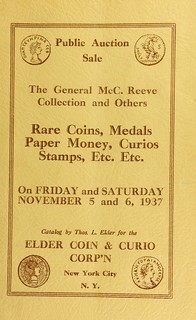
PREV ARTICLE
NEXT ARTICLE
FULL ISSUE
PREV FULL ISSUE
CHARLES MCCORMICK REEVEE-Sylum Feature Writer and American Numismatic Biographies author Pete Smith submitted this article on collector Charles McCormick Reeve. Thanks! -Editor
Charles McCormick Reeve
Reeve first came to my attention as I was doing pedigree research on U. S. large cents. The Elder
sale of November 5, 1937, was titled,
The catalog had this description: I had not realized that Charles McCormick Reeve and Charles Wyllys Betts were on the same 1870 Yale expedition until doing research last week. There are other similarities between the two and some differences. Charles Wyllys Betts was born in Newburg, New York, on August 13, 1845. Charles McCormick Reeve was born Danville, New York, on August 7, 1847. Both men came from prominent and successful families. Betts was the son of a judge. Reeve was the son of a general. Betts graduated from Yale College in 1867. Reeve graduated from Yale College in 1870. Reeve was a leader of the Yale Glee Club. Betts sang in the Trinity Church choir. Both received law degrees and practiced as lawyers. Betts was active in New York society and belonged to such clubs as the Union Club, the Country Club and the high prestige Knickerbocker Club. Those clubs did not exist in Minneapolis. Reeve was the founding president of the Apollo Club, a choral music society. He was also active in fraternal organizations, The Masons and Oddfellows.
Betts bought land on the shore of Lake Agawan on Long Island in an area that was developed into prime real estate. Reeve bought a 250 acre farm on the south shore of Lake Harriett. His investment paid off as the property was developed into choice neighborhood lots. He donated land for a park around the lake. I have run around the park and through his farm many times.
Betts wrote about his experiences in Betts died at age 41. Reeve lived nearly to the age of 100. He became the oldest living graduate of Yale and possibly the oldest living veteran of the Spanish American War. He is buried at Lakewood Cemetery on property on the north side of Lake Harriet across from the original Reeve farm. I have visited the gravesites of William Lanphere, Elias Rasmussen and A. M. Smith at that cemetery. Betts donated parts of his collection to Yale in his home town of New Haven and parts to the American Numismatic Society in New York. Reeve gave parts of his collection to Rollins College in his winter home in Winter Park, Florida, and parts to the Minnesota Historical Society in St. Paul. Some years ago, I was a volunteer at the Minnesota History Center. I worked on an inventory of their coin collections. Accession notes indicated that some Philippines coins were donated by Charles McCormick Reeve. I immediately recognized the name but they had no information on who Reeve was. I wrote an article explaining Reeve's heroic leadership during the Spanish American War, his service in the Philippines following the war and his important contributions to Minneapolis. This illustrates something that museums should know but some fail to keep good records. A bunch of coins donated to a museum may be no different from another bunch of coins. However, if you know who owned them, then the coins may illustrate a story. I was able to provide biographies of a couple of other donors including a former director of the museum. I have also done research at the Brown County Museum in my hometown. They have a dozen Indian War medals but no accession records. There is no indication of the Defenders who earned those medals. It should be obvious that I have an interest in pedigree research and the collectors who owned coins. I apply that interest to my collections. For example, I have written pedigrees for 190 different 1792 half dismes. I bought the piece with the most charming pedigree and the one pedigree that can be traced back the longest time. A more complete biography of Reeve is on the Newman Numismatic Portal for those who choose to read it. I will need to revise it to correct at least two errors I discovered.
Wayne Homren, Editor The Numismatic Bibliomania Society is a non-profit organization promoting numismatic literature. See our web site at coinbooks.org. To submit items for publication in The E-Sylum, write to the Editor at this address: whomren@gmail.com To subscribe go to: https://my.binhost.com/lists/listinfo/esylum All Rights Reserved. NBS Home Page Contact the NBS webmaster 
|


